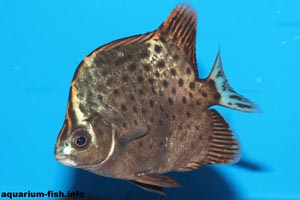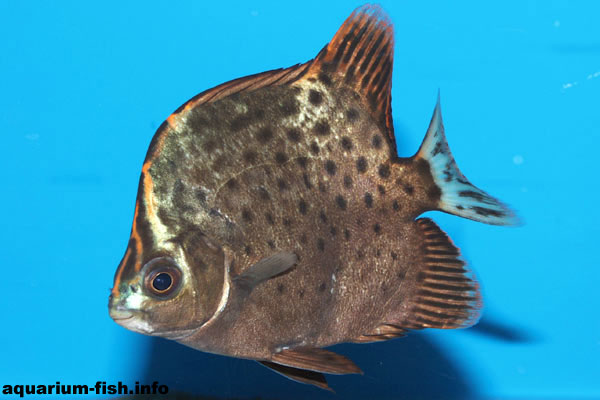

Species Profile | Images | Breeding Report | Similar Species

(Other members of the genus Scatophagus)
ADULT SIZE: 30 cm
WATER CONDITIONS: Brackish (tablespoon of seasalt/gallon)
TEMPERATURE RANGE: 23-27 C
FOOD: Feed Scatophagus argus anything, a true omnivore
DISTRIBUTION: This species comes from Indo-pacific
AQUARIUM CARE: Scatophagus argus hails from estuaries and coastal areas in much of the indo-pacific. Brackish water is acceptable in the short term, for juvenilles, but adult fish (which can grow quite large) require full marine water. This species is a true omnivore, that likes some vegetable matter, and can be trained to feed from the owners hand.
BREEDING: Unknown, but probably requires full marine conditions.
Have you bred Scatophagus argus? Why not fill in a breeding questionaire?, or examine existing Scatophagus argus breeding reports
Other members of the genus Scatophagus
Other oddball species
Other species from Indo-pacific

The scat comes in different colour forms - pictured here is the Red Tiger scat, sometimes called Scatophagus argus atromaculatus
BREEDING: Unknown, but probably requires full marine conditions.
Have you bred Scatophagus argus? Why not fill in a breeding questionaire?
This page summarises breeding reports provided by visitors to this site, along with some statistical analysis. Please feel free to contribute - whatever your experience!
| |||||||||
|
| ||||||||
| |||||||||
|
| ||||||||
Remember, each record represents only one persons experience; if you had different results, or used different methods, please share your experiences
| Water conditions: | Water temperature: 28oC+ |
| Disposition: Somewhat aggresive on occasions | Community tank?: Doubtful, only with VERY calm fish |
| Spawning Method: Adult fish removed from tank | Breeding problems: none |
| Sex ratio: | Breeding difficulty: Average |
| Sucess: Fairly sucessful | Years Experience: 4 |
| Other Comments: In India, Central Institute of Brackishwater Aquaculure, chennai has successfully bred Scatophagus argus through hormonal manipulation and juveniles produced. For breeding purpose the fish has to be maintained in 30 ppt and above salinity. Initially rotifer is suuplied as feed for the scat larvae and after 10th day post hatch, Artemia naluplii supplied. Scat larvae can be weaned to artificial diet from 20th day. No cannibalism noticed. | |
| Date this record created: 11th August 2011 | Breeding date: 2011 |
| Breeder: | Location: Chennai India |